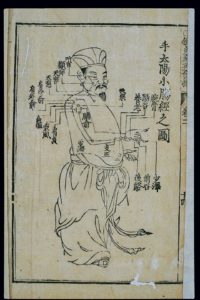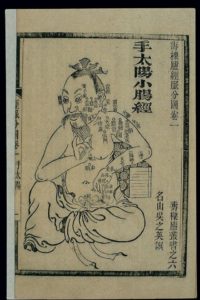Explanations of
Channels and Points Vol.1 –
Point Explanations VI
___________________________________________________________

The following post is an excerpt from《Explanations of Channels and Points Vol. 1》 [经穴解] translated by Michael Brown and edited by Allen Tsaur. It explicates the origin of point names from a new perspective and viewpoint.
The Small Intestine
________________________________________________
First Point of the Small Intestine
Shào Zé – Lesser Marsh (SI-1)
小腸經第一穴少澤
注:澤者,水之所聚也。以其在小指之端,而又爲小腸之井,故名少澤。
Explanation: Zé (Marsh) is the place where water accumulates. Because this point is located at the end of the little finger, and moreover it is the well [point] of the small intestine, therefore it is called Shào Zé (Lesser Marsh).
Third Point of the Small Intestine
Hòu Xī – Back Ravine (SI-3)
小腸第三穴後谿
注:谷谿皆水過之稱,以本節前爲前谷,所以本節後爲谿,與奇經督脈相通。蓋足太陽在督脈之兩旁,而此經自肩上與督橫交,故與督脈相通。
Explanation: valley and Xī (Ravine) are both names of places [where] water traverses. As the Front Valley (SI-2) is in front of the base joint, behind the base joint, there is the Xī (Ravine). It communicates with the extraordinary channel dū vessel. Even though the foot tàiyáng is located on the two sides of the dū vessel, this channel intersects horizontally with the dū vessel above the shoulders, thus, it communicates with the dū vessel.
Fifth Point of the Small Intestine
Yáng Gǔ – Yáng Valley (SI-5)
小腸經第五穴陽谷
注:陽指太陽經而言也,谷指本經離腕而上臂,至銳骨之前,經脈過之有空,似水從谷出之象也,故曰陽谷。
Explanation: regarding Yáng, it indicates the tàiyáng channel. Gǔ (Valley) indicates that when this channel is departing from the wrist to ascend the arm, it arrives in front of the protuberant bone; where the channel vessel passes, there is a hollow that resembles the image of water exiting a Gǔ (Valley), therefore it is called Yáng Gǔ (Yáng Valley).
Twelfth Point of the Small Intestine
Bǐng Fēng – Grasping the Wind (SI-12)
小腸經第十二穴秉風
注:穴在肩之下,正爲風之自外來者所中,故曰秉風。天髎乃手少陽三焦經穴,在肩缺盆中,毖骨際陷中央,缺盆上有起肉處是穴。
Explanation: this point is located below on the shoulder, it is exactly where the Fēng (Wind) comes from externally to strike [it], therefore it is called Bǐng Fēng (Grasping the Wind). Tiān Liáo (SJ-15) is a hand shàoyáng sānjiāo channel point. It is located at the midpoint between the shoulder and the sunken edge of the hidden bone that is located in the supraclavicular fossa. Above the supraclavicular fossa where the flesh first emerges, that is the point.
小顒,當作肩顒可也,此處穴中無小顒穴。
The small protuberance can be interpreted as head of the shoulder. For the points in this area, there is no such point called Xiǎo Yú (Small Protuberance).
手陽明雖會於此穴,而手陽明經自上循臑外之前廉,遂歷肘髎、五里、臂臑,以上肩之肩顒穴,
Even though hand yángmíng [is said to] meet at this point (SI-10); in fact, from the front ridge of the outside upper arm, the hand yángmíng channel passes through Zhǒu Liáo (LI-12), Wǔ Lǐ (LI-13), Bì Nào (LI-14), to the top of the shoulder which is Jiān Yú (LI-15).
出顒骨之前廉,循巨骨穴而上出天柱骨之會,會於大椎,無入肩後秉風之絡,其載會手陽明者,未詳考也。
It emerges at the front edge of collarbone, follows Jù Gǔ (LI-16) to ascend, and emerges to meet at the celestial pillar bone (cervical column), where it meets at Dà Zhuī (DU-14). It does not have a network to enter Bǐng Fēng (SI-10) in the posterior shoulder. For the record here where, “it meets with hand yángmíng,” this is due to the failure to examine it in detail.
手少陽循臑外上肩,而交出足少陽之後,遂入缺盆,亦無入肩外之絡,其載會於此穴者,亦未詳考也。
The hand shàoyáng follows the outside of the upper arm to ascend to the shoulder, where it intersects (SJ-15) behind the foot shàoyáng (GB-21). It then enters supraclavicular fossa (Quē Pén ST-12). It also does not have a network-vessel that enters the outside shoulder. For the record here where, “[shàoyáng channel] meets here,” this is also due to the failure to examine it in detail.
足少陽之會於此穴者,乃足少陽過天牖,行手少陽之前,下至肩上循肩井,却左右交出手少陽之後,過大椎、大杼、秉風,當秉風者前,入缺盆之外者,過秉風而與本經會於此穴,則三經之會本經,惟此可考耳。
Regarding “the leg shàoyáng meets here at this point;” [once] the leg shàoyáng [channel] passes Tiān Yǒu (SJ-16), it travels in front of the hand shàoyáng, and descends to the top shoulder. It then follows through Jiān Jǐng (GB-21), there, it intersects with hand shàoyáng and pulls back [medially] after emerging from behind [the latter]. It traverses to Dà Zhuī (DU-14), Dà Zhù (BL-11), and Bǐng Fēng (SI-10). Right in front of Bǐng Fēng (SI-10), it enters the lateral side of the supraclavicular fossa. It then traverses to Bǐng Fēng (SI-12) and meets with this channel at this point. Of the three channels that [allegedly] meet with this channel, only this one can be verified.
Sixteenth Point of the Small Intestine
Tiān Chuāng – Celestial Window (SI-16)
小腸經第十六穴天窗
注:此穴在頸之側,如室之有窗,在室之側也,故名天窗。
Explanation: this point is located on the side of the neck, resembling a room having Chuāng (Windows), which are located on the sides of a room, therefore it is named Tiān Chuāng (Celestial Window).
扶突爲手陽明大腸,在胃經氣舍上一寸五分,在頸當曲頰下一寸,去胃經人迎穴後一寸五分,此穴又在扶突後也。
Fú Tú (LI-18) is a hand yángmíng large intestine [point], it is located 1 cùn 5 fēn above Qì Shè (ST-11) of the stomach channel, on the neck it should be 1 cùn below the corner of the jaw, and 1 cùn 5 fēn behind from Rén Yíng (ST-9) of the stomach channel. Nevertheless, this point (SI-16) is located behind Fú Tú (LI-18).

_____________________________________
Post-Scriptum: The book is available on amazon under the following link:
https://www.amazon.com/Explanations-Channels-P…/…/1703778715
PPS: Vol. 2 will be released this year.
PPPS: Pictures are from wellcomecollection.org
